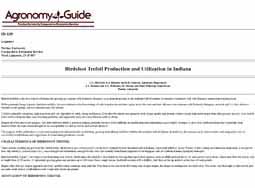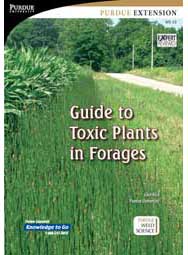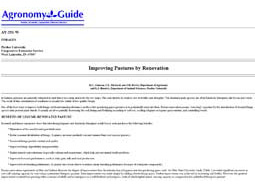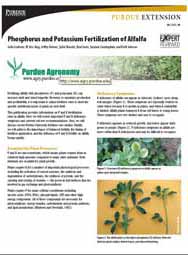Crops
Forage Crops
Beef Management Practices: When Forages are in Short Supply Because of Drought
A drought year can affect a beef producer's bottom line for three years. Proper planning and management can minimize the longer-term economic impact. In this publication, Purdue University experts review 18 management pr...
Birdsfoot Trefoil Production and Utilization in Indiana
Provides management information for establishing, growing and utilizing birdsfoot trefoil in the northern half of Indiana....
Provides photos and brief descriptions of various insect pests of forage legume crops.
Format: PDF.
Pages: 2.
Language: English.
...Considerations for Stretching Forage Supplies
This two-page publication entitled, "Considerations for STRETCHING Forage Supplies" discusses the dismal season for forage producers and how they can reduce problems caused by the weather. Keeping track of inventory o...
Considerations When Using Soybeans as a Forage
This three-page publication entitled, "Considerations When Using Soybeans as a Forage" discusses the idea of harvesting soybeans as a forage. Those soybeans that don't reach physiological maturity before a freeze take...
Field Crops: Alfalfa Insect Control Recommendations
This publication is an aid for pest managers in treating insect pest infestations in alfalfa during the growing season.
Format: PDF.
Pages: 6.
Language:...
Forage Field Guide, fourth edition
The new fourth edition of this guide contains 324 pages of information for forage and livestock producers and the agricultural industries that serve them. This new edition features updates and changes throughout, includi...
Forage Field Guide, fourth edition (25/box)
This is a box of 25 copies of our popular in-field reference. The fourth edition of this pocket-size, in-field reference provides information for forage and livestock producers and the agricultural industries that serve ...
Forage Selection and Seeding Guide for Indiana
The purpose of this publication is to simplify the process of forage selection for the producer by collecting all of the relevant information and presenting it in one place and in convenient form. The relative advanta...
Forages and Feeding Dairy Cattle During Drought Conditions
Drought conditions create numerous challenges on a dairy farm, including slow regrowth of pasture, hay and crops to be ensiled, reduced yields, lower forage quality and increased production costs. This publication looks ...
This guide provides an overview of the current knowledge of fungicides and their use on field crops. This comprehensive book combines past knowledge about fungicides with recent developments in the realm of field crop fu...
Guide to Toxic Plants in Forages
Several plants in our pastures can be toxic to horses and cattle. The best way to assure that forage is as safe as possible is to keep these plants out of your fields and pastures. Doing this, requires proper weed i...
Improving Pasture by Renovation
Discusses steps to successfully renovate pasture land to improve both forage yields and animal performance. ...
Management-Intensive Grazing in Indiana
Grazing systems management is a combination of art and science. You will have to master the art as it relates to your farm, but this manual will get you started on the science. It outlines the basics of grazing systems...
Managing Prussic Acid in Sorghum
Prussic acid poisoning can be a concern if livestock consume freeze-damaged sorghum plants. This concern can be minimized if management strategies are utilized. This video discusses ways to manage sorghum so prussic acid...
Managing the Prussic Acid Hazard in Sorghum
Sorghum is a valuable forage crop but can produce prussic acid (also known as hydrogen cyanide, HCN), which can be toxic to livestock. In this publication, Purdue and Kansas State researchers discuss characteristics affe...
Maximizing the Value of Pastures for Horses
The purpose of this publication is to help horse owners get the most out of the time, effort, and money they are (or should be) putting into permanent pasture management. Discussed first are two basic pasture-planning de...
Minimizing Tall Fescue Toxicity
Discusses the method of transmission, symptoms of poisoning, probable toxin source, and methods of control for both new seedlings and established stands....
Minimizing the Prussic Acid Poisoning Hazard in Forages
A publication which discusses the prussic acid poisoning hazard in forages, the signs of prussic acid poisoning, factors affecting prussic acid content in plants, safe feeding of potentially hazardous forages and treat...
Pasture Assessment for Water Resource Protection
Using the Quick Check and the Action Plan included in this publication can help determine, and prevent, high risks for possible water contamination associated with pastured animal production. It also includes local organ...
Phosphorus and Potassium Fertilization of Alfalfa
Fertilizing alfalfa with phosphorus (P) and potassium (K) can increase yield and the stand's longevity. However, to maximize production and profitability, it is important to adjust fertilizer rates to meet the specific n...
Producing Emergency or Supplemental Forage for Livestock
This publication discusses the selection and management of emergency or supplemental forage crops....
Presented here is a procedure for selecting that legume species best suited to a field based on its particular combination of drainage, fertility and pH (degree of acidity)....
Sensory Analysis of Hay Quality for First- Time Buyer
Sensory analysis is one of two methods that producers use when buying appropriate hay to meet animal requirements in a cost-effective manner. A forage test is the other. In this paper, two Purdue University experts ex...
Sweetclover Production and Utilization in Indiana
Discusses the characteristics of biennial sweetclovers, as well as variety selection and planting and fertilizing recommendations....
Tall Fescue - Establishment and Management
Discusses the characteristics of tall fescue, its establishment, fertilization, maintenance, renovation and harvesting as pasture of hay....
Making excellent quality hay is a process that requires proper use of the right harvest equipment at the right stage of forage growth. Doing this will minimize yield and quality losses so nutritional needs of livesto...
To make excellent quality hay, the forage needs to be cut at the right growth stage and packaged into a bale at the right moisture content without incidence of rain damage. Baling hay too wet can result in mold format...
Tri-State Fertilizer Recommendations for Corn, Soybeans, Wheat & Alfalfa
In this cooperative effort, Extension experts from The Ohio State University, Michigan State University, and Purdue University revamp the original Tri-State Fertilizer Recommendations for Corn, Soybeans, Wheat and Alfalf...
Weed Management in Pastures: Spiny Pigweed
Spiny pigweed can often be found in pastures that are heavily grazed and in need of some attention. In pastures, spiny pigweed is a competitive weed and has been associated with nitrate accumulation in livestock. This pu...






































